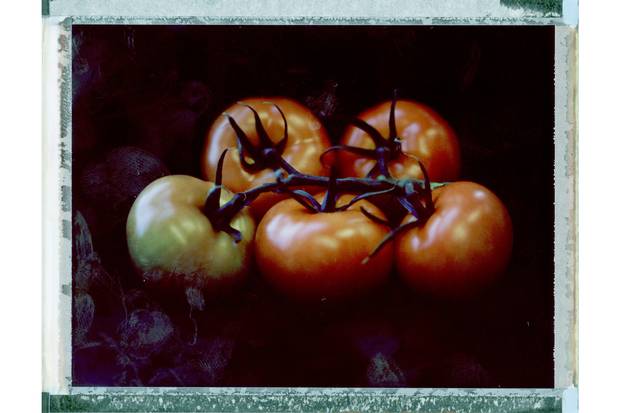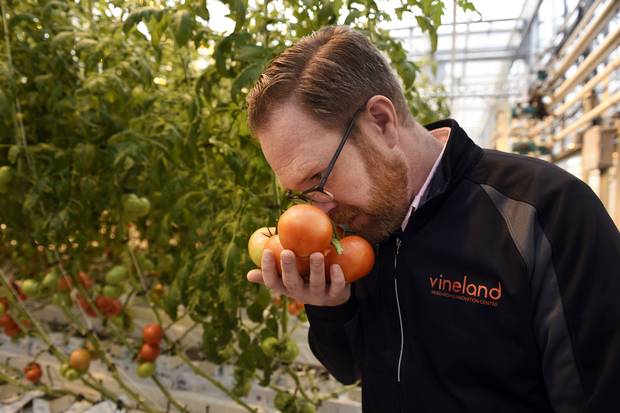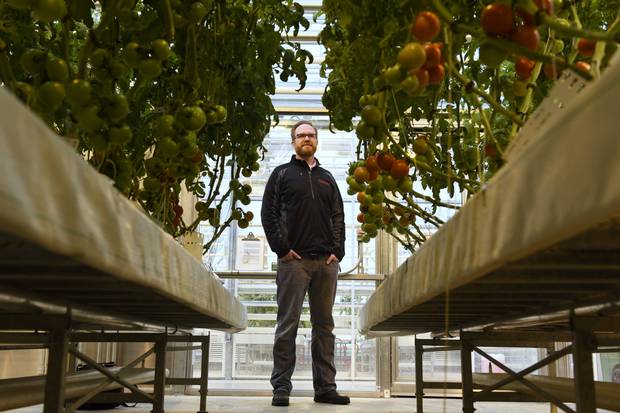From the time of planting, it takes between two and three months for an average greenhouse tomato plant to produce fruit. But by the time David Liscombe's plants bear fruit this spring – glistening red, orange, and yellow orbs hanging down like charms from a ragged vine bracelet – those tomatoes will have been years in the making.
Mr. Liscombe is no farmer. Instead, he's a biochemist who talks about his tiny potted sprouts and seeds in the same way the late Steve Jobs described iPhones – many of the details top-secret, and each product the result of endless research and testing.
"It's an iterative process," he said one recent morning at the government-funded Vineland Research and Innovation Centre in Niagara, Ont., where he works. Looking out at the empty greenhouse in front of him, he pointed to the areas where the "elite" lines he's been working on since 2013 will be planted. Each of the over 100 varieties planted will be brand-new creations, the result of hours spent in a laboratory extracting and analyzing genetic data.
All that work has gone toward understanding what it is that makes a tomato taste like a tomato. The ultimate hope is that one of his new varieties will be a tastier one – and become the next grocery-store tomato.
"Those," he said, gesturing to the space where his tomatoes will eventually grow, "will potentially be the final product."
The project, funded in part by the Ontario greenhouse industry, not only benefits the consumer who is tired of the flavourless, mealy grocery-store tomato.
It also marks an ideological shift in commercial fruit and vegetable growing.
For the past half-century, almost all agricultural research has focused on yield – increasing production and disease-resistance, generally at the expense of flavour. The result has been the omnipresence of bland but high-performing grocery-store tomatoes – nicknamed by one researcher "Model T" tomatoes. But producers are noticing consumers' changing tastes – not just in tomatoes, but in other fruits and vegetables, as well.
Now, research is turning its attention back to flavour. In turn, that research is raising fundamental questions about our food system: What do we value, and why? Have we become a society that no longer knows how fruits and vegetables are supposed to taste?
And among tomato growers, it's opening up new discussions about their work: whether a tomato is simply a commodity – one indistinguishable from the next – or whether customers might begin to expect something more.

Horticultural science professor Harry Klee: ’What we’re trying to do is basically be the Starbucks of tomato.’
"People feel the modern tomato is an embarrassment," said Harry Klee, a University of Florida horticultural science professor and the leading expert on tomato flavour. In the 1980s, Prof. Klee was working at Monsanto, researching genetically modified tomatoes, when he had a realization: They were producing a product that nobody wanted. So, he moved to academia in order to pursue flavour research.
At the time, the tomato had proved elusive to scientists. Most other fruits have just one or a few volatile compounds – the chemicals that give rise to flavour and aroma – that influence how they taste. A banana, for example, has just one dominant compound. If most people were to catch a whiff of isoamyl acetate, they would instantly recognize it as the smell of a banana. The flavour of an average tomato, by contrast, is made up of about 40 volatile compounds, which is what makes it so difficult to pin down.
Most people describe tomato flavour in terms of its balance between sweet and sour. Others may note a savoury, umami element. But true tomato experts, and scientists like Prof. Klee and Mr. Liscombe, detect further complexities – floral or citrus notes, or grassy, herbaceous ones.
Through his research, Prof. Klee began to crack the code of how these flavours are created, documenting which compounds are important in creating flavour, and which compounds are responsible for which aroma.
At Ontario's Vineland facility, Dr. Liscombe and his team – including Université Laval's Charles Goulet, who did his postdoctoral work in Prof. Klee's Florida lab – are further building upon this research. Over the past three years, the team has been cataloguing the genetic traits contained in hundreds of varieties of tomatoes and linking those traits with their corresponding flavour traits. At the same time, they've conducted consumer tests to understand which flavour customers prefer.
Armed with both sets of data, they've begun to breed brand-new varieties of tomatoes. The tomatoes that will grow in Vineland's greenhouse this spring will be their first attempt at some of these hybrids.
One recent afternoon in his lab, Dr. Liscombe held up a clear glass tube filled with small cubes of diced tomato. Over the course of an hour, one of his assistants would inject air into the tube – air that would pick up the tomato's aroma chemicals before getting trapped at the bottom of the tube. This exercise would produce a tiny amount of clear liquid – about 200 microlitres in a small glass capsule – which he could plug into a computer able to "read" its aromatic chemical contents.
Unlike Prof. Klee, who has created new varieties of tomatoes aimed mainly at home gardeners, Dr. Liscombe's product is aimed at commercial growers. Vineland's project is funded in large part by the Ontario Greenhouse Vegetable Growers association, and, as such, aims within the next few years to deliver to growers a tasty tomato that will also have the traits necessary for large-scale, commercial production in Ontario's unique environment.
Prof. Klee's hope is that this type of research will lead to a revolution in how people view produce.
"Thirty years ago, nobody was willing to pay $2 for a cup of coffee," he said. Most people made their coffee at home from instant, and there was very little differentiation between brand or bean. But when they tried Starbucks, he said, "people were like, 'Oh my God, that's what coffee's supposed to taste like.'" And thus the entire culture was changed.
"What we're trying to do," he said, "is basically be the Starbucks of tomato."
The tomato at your grocery store has seen many incarnations. But whether it's the Big Zebra (a fist-sized tomato with gnarled, green-and-gold striped skin), the white-fleshed Italian Ice, or the football-shaped Romas at Loblaws, all of the hundreds of varieties that exist today descend from a cranberry-sized fruit from Peru called Solanum pimpinellifolium.
After travelling across Latin America, a few seeds were brought to Europe by Spanish explorers in the 16th century. And in the centuries following, the plant was bred and crossbred by farmers, biologists and seed companies around the world into hundreds of different varieties of every size, shape and colour imaginable.
But the rise of industrial agriculture changed everything. The focus in breeding shifted from size and flavour to yield. At the same time, new considerations arose: the ascent of supermarkets, for example, meant tomatoes had to withstand harvest, packing, and long periods of travel before display on a shelf weeks later.
With each new development came more compromises to flavour. In this spirit, just a few varieties emerged as most popular in Canadian grocery stores: the Komeett, the Endeavour and Vendor – known for their high-yield potential, disease resistance, and hardiness.
Barry Estabrook, a U.S. food writer whose 2011 book Tomatoland served as an indictment against industrial agriculture, said that the entire economic system surrounding the fruit is set up against flavour.
Plant breeders sell their seeds directly to growers, he said. And for most growers, it doesn't matter whether they're producing the tastiest tomatoes or the blandest – they're paid based on weight. So for both the breeders and the growers, there's little or no incentive to pay attention to flavour.
"I think the most honest thing that I've encountered in my research was some corporate farmer in Florida – I brought up taste, and he looked at me as if I had four eyes," said Mr. Estabrook. "He said 'Barry, I don't get paid a cent for taste. I get paid by the pound of tomatoes, and I get more for bigger tomatoes. Period.'"
And it's not just tomatoes. Many of our fruits and vegetables – strawberries, peaches and watermelon, in particular – lack flavour for the very same reasons.
"It's food porn," said Mr. Estsabrook. "It looks good, but it doesn't deliver."
Who is to blame? It depends on whom you ask. Some blame breeders and growers, who they say are overly focused on quantity over quality. But others, too, blame customers.
"The reality is the vast majority of people don't want to pay more for their food," said Prof. Klee. "The reality is most people don't want to eat like [famed locavore] Alice Waters at Chez Panisse. They want to eat what they want, when they want it."
Still, in the past decade and a half, some cracks have begun to appear in Prof. Klee's assumptions.
In 1994, Paul Mastronardi introduced a new variety of tomato to the market – the Campari. Mr. Mastronardi's grandfather Umberto was the first to build large-scale greenhouse operations in North America in the 1940s, and today the family company represents about one-quarter of Ontario's greenhouse tomato industry.
Paul Mastronardi first came across the deep red, golf-ball-sized fruit during a trip to Holland, and was amazed when he bit into it and his mouth filled with sweet, tangy juice. But North American customers weren't convinced. At the time, they were still accustomed to softball-sized fruit, and reluctant to try something new.
But within a few years, around the year 2000, Mr. Mastronardi said things began to change. He pointed to foodie culture as a major driver – TV cooking shows and celebrity chefs introduced the public to new varieties of ingredients. The Internet became a new vehicle for recipe-sharing and the exchange of ideas surrounding food. "People now are a lot more open to experimenting," he said.
In the same time, grocery stores went from carrying about five varieties of tomatoes to a dozen or more. And while the "Tomatoes on the Vine, or "TOVs" (Komeett and the like) remain the No. 1 seller, the next category – the specialty grape, cherry and Campari varieties – are beginning to eat into that share. And customers began to warm to the Campari. Last year alone, Mr. Mastronardi sold 10 million pounds of them.
This shift translated into huge money, which explains why the industry has begun funding research like the project at Vineland. Tomatoes represent the country's largest fresh-vegetable export, responsible for about $500-million in annual farm-gate sales. Ontario's greenhouse vegetable industry, meanwhile, sold about $820-million worth of vegetables last year – one-third of that consisting of tomatoes. But with constant competition from imported producers from places such as Mexico – and even neighbouring provinces, where the industry's biggest expense, electricity, is cheaper – competing based on price has become more and more difficult.
"Canadian producers need to innovate in order to offer a differentiated product that will give them a competitive edge," the Vineland project description states. In other words, they're now competing for tastebuds.
In the fall of 2014, about 200 men and women of varying ages and ethnicities filed into an office building in the north end of Toronto. There, they were split up into separate rooms – about a dozen people per room – and seated at individual tables.
Over the course of an hour, each participant was given a succession of tomato wedges to sample – 19 varieties in total. After tasting each wedge, the testers were asked to answer a series of questions: On a range from "extreme dislike" to "extreme like," how much did they like the tomato? How would they describe the tomato? What were their purchasing habits when it came to tomatoes?
These panels, run by a consumer-research division at Vineland, helped to frame Mr. Liscombe's work in deciding which traits to include in the new breeds.
Some of what they learned was that customer preferences are all over the map. Some preferred a little bit of sweetness and a touch of umami; others liked more vegetal, smoky aromas.
But the common denominator, Vineland's Amy Bowen said, was texture, which trumps everything else. Customers across the board are looking for skin that's just a touch al dente – and fruit that bursts into a mouthful of juice at the bite. "If texture wasn't there – either it was too firm or too soft – it didn't matter how sweet or how flavourful or what volatiles it had," she said.
Others, like Mr. Klee, have done similar testing in the U.S. to find even more specific breakdowns of who likes what. Younger people, he found, tend to like tomatoes with a higher sugar content, while older ones prefer a more complex flavour profile.
And what people prefer in a tomato often has to do with how they use it. Northern Europeans, who tend to use the fruit in sandwiches and salads, prefer a sweeter fruit. Hispanics, who tend to cut them up into salsa, prefer a firmer, high-acid tomato.
In general, what the Vineland group found is that about 60 per cent of the respondents liked the average grocery-store tomatoes. But some of the specialty varieties that already exist were liked by 80 to 100 per cent of respondents. That gap, Ms. Bowen said, shows there's room for improvement.
When asked about their personal preferences in a tomato, most of the experts interviewed cited a balance between sugar and acid. Others named popular varieties, like the Brandywine, or kumato. But Ms. Bowen's response was perhaps the most revealing of Vineland's mandate.
To her, individual feelings matter less than data and science. "In all honesty, it doesn't matter what I think is a perfect tomato," she said. "It matters what the research says is the perfect tomato."

David Liscombe: ‘When you use winemaking as an example – there’s a lot of science that goes into winemaking. And there’s also a lot of science that goes into all the different varieties of vegetables we eat.’
Around the time the leaves begin to change colour each year, Vicki Emlaw and Tim Noxon host their annual tomato-tasting event at their farm in Prince Edward County, Ont. The pair run Vicki's Veggies, a small organic farm that focuses on specialty and heirloom tomatoes, and the event each year is a feast for the stomach and eyes. At the centre is a giant harvest table decorated with wildflowers, along with samples of hundreds of varieties of tomatoes in every colour of the rainbow.
When Mr. Noxon talks about tomatoes, he uses language more commonly applied to wine. He speaks of terroir – of the tomato as an expression of its natural environment, soil, climate and topography. And unlike Ms. Bowen, he talks about feelings, and emotions. "We're organic growers and we have a somewhat emotional attachment to producing vegetables. We don't do it because it's an industry. We do it because we love it," he said.
Mr. Noxon has no problem citing his personal tomato preferences, and is skeptical that the confluence of factors that produce truly great flavour – intense sunlight, the natural swing between warm day and cool nights – can be replicated by focus groups and scientists in lab coats.
"I don't think we're ever going to be able to have a tomato that tastes as good as it does from a field, picked on a warm day at the end of August or early September," he said.
He acknowledged that nostalgia plays a part, too – that many consumers who shop at farmers' markets and prefer heirloom products are buying an idea as much as a product. "You hear over and over again," he said, "people say 'I really want to taste a tomato like I used to taste on my grandfather's farm.' "
He's not the only skeptic.
Mr. Estabrook compared plant breeding to a Rubik's cube. Lining up the first and second side of the cube is easy – just like achieving one or two tomato qualities, such as disease-resistance and hardiness. But to add a third or fourth component – flavour, aroma – while keeping the other two sides intact becomes much more challenging.
"It's a grail, and it's not an impossible grail," he said. "But it's going to be – it's hard to foresee how it's really going to be met."
Dr. Liscombe acknowledged that the lab environment reduces the chance of happy accidents like the ones Mr. Noxon described. "I totally respect that viewpoint. In a lot of ways, I believe in the same sort of – the spirit of the tomato," he said. But, he said, in order to produce food on the scale necessary to feed a growing population, science and precision are crucial.
"When you use winemaking as an example – there's a lot of science that goes into winemaking," he said. "And there's also a lot of science that goes into all the different varieties of vegetables we eat."
One recent evening, Dr. Liscombe harvested all the fruit that remained in the greenhouses after a round of testing. Of those dozens of varieties, he took one of each home with him. Over the course of the next few nights, he tasted every single one.
Some of them were bland and watery. Others, he said, tasted "actively gross." Still, this contrast helped him identify the good ones.
And every so often, he stumbled across a variety that gave him goosebumps. He closed his eyes, as if to recall the taste.
"They were just …" his voice trailed off as he searched for the word to describe it. Then he found it. "Delicious."
Ann Hui is the national food reporter at The Globe and Mail. Follow her on Twitter: @annhui
ANN HUI ON FOOD: MORE FROM THE GLOBE AND MAIL




